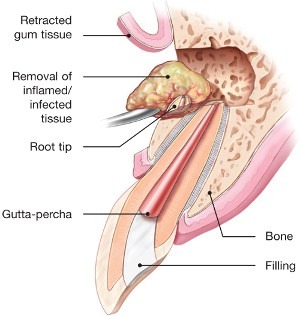Endodontic Microsurgery: What It Is and When It’s Needed
Imagine your tooth as a fortress, with each layer providing protection and support. But what happens when the enemy breaches the walls? When a standard root canal treatment isn’t enough to save your tooth, it’s time to consider endodontic microsurgery.
This delicate procedure, akin to a skilled surgeon’s precision, can be the last line of defense for your tooth. But what exactly is endodontic microsurgery, and when is it truly needed?
Let’s explore the fascinating world of this specialized dental procedure, where microscopic tools and expert hands come together to save your smile.
The Basics of Endodontic Microsurgery
Endodontic microsurgery, also known as apical microsurgery, is a minimally invasive procedure that’s performed when traditional root canal treatment isn’t sufficient to save a tooth. This type of surgery is used to treat issues in the root of a tooth, such as infection or damage that can’t be resolved through conventional means. It involves accessing the root tip through a small incision made in the gum tissue, allowing the endodontist to remove the infected or damaged tissue and perform any necessary repairs.
During the procedure, a high-powered microscope is used to provide the endodontist with a magnified view of the treatment area, ensuring precision and accuracy. The use of microsurgery techniques allows for better visualization of the root canal system and enables the endodontist to effectively locate and treat any hidden canals or fractures. This results in a higher success rate and a better chance of saving the affected tooth.
Endodontic microsurgery is typically recommended when a tooth has persistent symptoms, such as pain or swelling, despite previous root canal treatment. It’s also an option when a tooth has a persistent infection or when retreatment of a previous root canal isn’t possible. By opting for endodontic microsurgery, you can increase the chances of preserving your natural tooth and avoiding the need for extraction and eventual replacement with a dental implant or bridge.
Performing Endodontic Microsurgery
To perform endodontic microsurgery, you make a small incision in the gum tissue to access the root tip of the tooth. This procedure is typically done using a dental operating microscope, which provides magnification and illumination to enhance visibility.
Once the root tip is exposed, any infected or inflamed tissue is carefully removed. The next step involves locating and cleaning the root canal system. This is done by using ultrasonic instruments and a special dye to identify any cracks or fractures in the tooth.
After cleaning the root canal system, a biocompatible material, such as mineral trioxide aggregate (MTA), is placed to seal the root tip and prevent any further infection.
Finally, the incision in the gum tissue is sutured back together, and you’ll be given post-operative instructions for care and follow-up.
It’s important to note that endodontic microsurgery is a highly specialized procedure that requires advanced training and expertise. If you’re in need of this type of treatment, it’s essential to seek out an experienced endodontist who can provide you with the best possible care.
Conditions Requiring Endodontic Microsurgery
When considering the need for endodontic microsurgery, it’s important to understand the specific conditions that may require this specialized procedure.
While most root canal treatments are successful, there are instances where the initial treatment may not fully resolve the issue. In such cases, endodontic microsurgery may be necessary to address the underlying problem.
One condition that may require endodontic microsurgery is persistent or recurrent infection. Despite the best efforts of the dentist, some infections may persist or reoccur after the initial root canal treatment. Endodontic microsurgery allows the dentist to access the root tip and remove any infected tissue or bacteria that may be present. By eliminating the source of the infection, the dentist can effectively treat the problem and prevent further complications.
Another condition that may warrant endodontic microsurgery is the presence of a cracked root. Cracks in the root can occur due to trauma, decay, or excessive pressure. These cracks may not be visible on an X-ray and can lead to persistent pain or discomfort. In such cases, endodontic microsurgery can help locate and treat the crack, improving the chances of saving the tooth.
Benefits of Endodontic Microsurgery
One major benefit of endodontic microsurgery is the ability to precisely locate and treat hidden root canal issues. With the use of a powerful microscope and specialized instruments, your endodontist can perform intricate procedures with enhanced precision and accuracy.
Here are some key benefits of endodontic microsurgery:
– Improved visualization: The high magnification of the microscope allows your endodontist to see even the tiniest structures inside your tooth, ensuring that no hidden canals or fractures are left untreated.
– Minimally invasive: Microsurgery techniques involve making small incisions and accessing the root canal system without the need for extensive tissue removal. This results in minimal discomfort, faster healing, and reduced post-operative swelling.
– Preservation of healthy tooth structure: By precisely targeting the problem areas, endodontic microsurgery helps preserve as much healthy tooth structure as possible, avoiding unnecessary tooth extraction.
– Enhanced success rate: The meticulous nature of microsurgery improves the success rate of the procedure, ensuring a higher chance of saving your natural tooth and avoiding more invasive treatment options.
– Long-term tooth preservation: With the ability to address complex root canal issues that may have been missed during conventional treatment, endodontic microsurgery enhances the longevity of your tooth, allowing you to maintain a healthy smile for years to come.
Indications for Endodontic Microsurgery
Are you wondering when endodontic microsurgery may be necessary?
Let’s talk about the indications.
One of the main reasons for surgical root canal treatment is when a traditional root canal procedure has failed to fully resolve the issue.
Understanding the success rates and outcomes of endodontic microsurgery can help determine if it’s the right option for you.
Surgical Root Canal Treatment
To determine if you need endodontic microsurgery for your root canal treatment, your dentist will assess the severity and complexity of your dental condition. If your root canal has failed, or if there are persistent symptoms such as pain, swelling, or infection, surgical intervention may be necessary. Here are five indications for endodontic microsurgery:
– Presence of a persistent infection or abscess that can’t be adequately treated with conventional root canal therapy.
– Root canal anatomy that’s difficult to navigate or treat through nonsurgical means.
– Root fractures or damage that can’t be repaired through nonsurgical methods.
– Residual infection or inflammation in the bone surrounding the root tip.
– Need for removal of cysts or other pathological tissues near the root tip.
Your dentist will carefully evaluate your situation to determine if surgical root canal treatment is the best option for you.
Success Rates and Outcomes
If you have been recommended surgical root canal treatment, understanding the success rates and outcomes of endodontic microsurgery is crucial.
The success rates of endodontic microsurgery are generally high, with studies reporting success rates ranging from 80% to 95%. This means that in the majority of cases, the procedure effectively eliminates infection and restores the health of the tooth.
However, it’s important to note that the success of the surgery depends on various factors, such as the skill and experience of the endodontic surgeon, the complexity of the case, and the patient’s oral hygiene habits.
Additionally, it’s essential to follow proper post-operative care instructions to ensure the best possible outcome.
Making Informed Decisions About Endodontic Microsurgery
When considering endodontic microsurgery, it’s important to be aware of its benefits and the factors that can affect surgical outcomes.
Microsurgery offers advantages such as improved visualization and precision, leading to better treatment outcomes.
However, factors like the complexity of the case and the skill of the endodontist can also impact the success of the procedure.
Benefits of Microsurgery
Consider the advantages of endodontic microsurgery to make an informed decision about its benefits. Here are five reasons why microsurgery may be beneficial for you:
– Enhanced precision: With the use of microscopes and specialized instruments, the dentist can perform intricate procedures with utmost accuracy, ensuring better outcomes.
– Minimally invasive: Microsurgery involves making smaller incisions, resulting in less trauma to the surrounding tissues and faster healing time.
– Increased success rate: The high magnification and illumination provided by microscopes allow the dentist to identify and treat even the smallest root canal issues, leading to a higher chance of successful treatment.

– Preservation of natural tooth: Microsurgery enables the dentist to save your natural tooth by removing infected tissue and sealing the root canal, preventing the need for extraction.
– Reduced discomfort: The minimally invasive nature of microsurgery means less post-operative pain and discomfort, allowing for a quicker recovery.
Factors Affecting Surgical Outcomes
To make an informed decision about endodontic microsurgery, it’s essential to understand the key factors that can affect surgical outcomes.
One important factor is the skill and experience of the endodontic surgeon. A surgeon with extensive training and a high level of expertise is more likely to achieve successful outcomes.
Additionally, the type and complexity of the case can also influence the surgical outcome. Complicated cases, such as those involving curved canals or calcified root canals, may pose greater challenges and require advanced surgical techniques.
The condition of the surrounding tissues and bone also plays a role in determining the success of the surgery. If there’s significant inflammation or infection present, it may compromise the healing process.
Lastly, patient compliance with postoperative instructions and proper oral hygiene practices can significantly impact the outcome of the surgery.
Frequently Asked Questions
Are There Any Risks or Complications Associated With Endodontic Microsurgery?
There are risks and complications associated with endodontic microsurgery. These can include:
– Post-operative pain, swelling, and bruising.
– In rare cases, nerve damage or infection may occur.
It’s important to follow post-operative instructions carefully and report any unusual symptoms to your dentist. They can provide guidance and treatment if necessary.
It’s always best to discuss any concerns or questions with your dentist before undergoing endodontic microsurgery to ensure you’re fully informed.
How Long Does the Recovery Process Typically Take After Endodontic Microsurgery?
The recovery process after endodontic microsurgery typically takes a few days to a week. During this time, you may experience some discomfort and swelling, but these symptoms should gradually improve.
It’s important to follow your dentist’s post-operative instructions, such as taking prescribed pain medications and avoiding certain foods.
Be sure to attend your follow-up appointments to ensure that the healing process is progressing as expected.
Can Endodontic Microsurgery Be Performed on Children or Teenagers?
Endodontic microsurgery can be performed on children or teenagers in certain cases. It’s important to consult with a qualified endodontist to determine if this procedure is appropriate for your child’s specific dental needs.
Factors such as the maturity of the tooth and the extent of the dental issue will be considered. The endodontist will be able to provide a thorough evaluation and discuss the potential benefits and risks of the surgery for your child.
Is Endodontic Microsurgery a Permanent Solution for Tooth Pain or Root Canal Issues?
Endodontic microsurgery can be a permanent solution for tooth pain and root canal issues. By removing infected tissue and sealing the root canal, it helps to eliminate the source of the pain.
The procedure is performed by an endodontist, who uses a dental operating microscope for precision.
It’s important to follow post-operative instructions and maintain good oral hygiene to ensure long-term success.
Consult with your dentist to determine if endodontic microsurgery is the right option for you.
What Is the Cost of Endodontic Microsurgery and Does Insurance Typically Cover It?
The cost of endodontic microsurgery and whether insurance covers it can vary. It’s best to consult with your dentist or endodontist to get specific information for your situation. They can provide an estimate of the cost and check if your insurance plan covers the procedure.
Keep in mind that insurance coverage can depend on your plan and the specific circumstances of your case.
Conclusion
So, if you’re facing a complex endodontic issue that can’t be resolved through conventional root canal treatment, endodontic microsurgery may be the solution for you.
This minimally invasive procedure offers numerous benefits, including increased success rates, reduced healing time, and improved aesthetics.
By making informed decisions and cons read this post here ulting with a skilled endodontist, you can ensure the best outcome for your dental health.
Don’t hesitate to explore this option if needed.

Welcome to my website! I am Patrick Oxenham, a dedicated and passionate Pediatric Dentist with years of experience in providing comprehensive dental care for children. I am thrilled to share my knowledge and expertise in smile restoration methods, aesthetic dentistry updates, and gum health and grafting with you.

